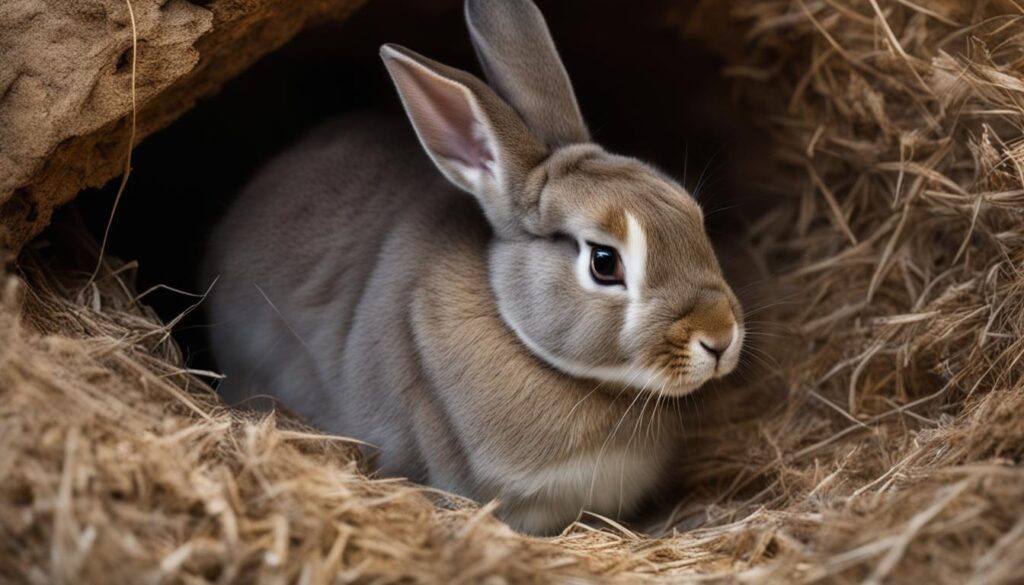Rabbit breeding can be a rewarding and fulfilling hobby, but it requires knowledge and preparation to ensure success. Understanding the breeding cycle and following best practices is essential for producing healthy and thriving litters. This section outlines the process of rabbit breeding, from mating to birth, and provides tips for successful breeding.
Key Takeaways:
- Rabbit breeding requires knowledge and preparation for success.
- Understanding the breeding cycle is essential for healthy litters.
- Following best practices is crucial for successful rabbit breeding.
- Factors such as suitable breeding rabbits, proper preparation, and attentive care during the birth and post-birth period are essential for thriving litters.
- By following best practices and guidelines, rabbit breeding can be a rewarding and fulfilling hobby.
Understanding Rabbit Mating Cycles
Rabbits are seasonal breeders, which means that they have specific times of the year when they are most fertile. Understanding the mating cycles of rabbits is crucial for successful breeding. Typically, the breeding season for rabbits begins in late winter or early spring when the days start to get longer. This period runs from January to August, with the peak breeding season occurring between February and May.
Different breeds of rabbits may have slightly different breeding cycles, which can affect their fertility and the success of breeding attempts. Additionally, factors such as age, health, and nutrition can also impact a rabbit’s breeding cycle.
Identifying When a Rabbit is Ready for Mating
Female rabbits are receptive to mating during specific periods of their estrus cycle. These periods typically last for around 12-14 hours and occur every 16-18 days. It is important to identify when a female rabbit is ready for mating to improve the chances of a successful breeding attempt. Signs that a female rabbit is ready to mate include:
- Increased activity and restlessness
- Relaxed posture and raised tail
- Vocalizations and spraying of urine
Male rabbits, on the other hand, are typically ready to mate throughout the breeding season. However, it is best to introduce the male rabbit to the female during her receptive period to improve the chances of successful mating.
Tips for Successful Breeding During the Rabbit Breeding Season
| Tip | Description |
|---|---|
| Monitor breeding cycles | Keep track of the breeding cycles of your rabbits to ensure that you are attempting to breed them during their most fertile periods. |
| Provide proper nutrition | Feeding your rabbits a balanced diet that includes plenty of hay, fresh vegetables, and a limited amount of pellets can improve their health and fertility. |
| Monitor rabbit health | Regularly check your rabbits for signs of sickness or injury and address any issues promptly to avoid impacting breeding success. |
| Introduce rabbits gradually | Introduce rabbits to each other gradually and monitor their behavior for signs of aggression or stress. |
By understanding the mating cycles of rabbits and employing these tips, breeders can improve their chances of successful breeding and producing healthy offspring.
Selecting Suitable Breeding Rabbits for Successful Rabbit Breeding
Successful rabbit breeding begins with selecting suitable breeding rabbits. When deciding on rabbits for breeding, there are several factors to consider to ensure a successful breeding program.
Health
The health of the breeding rabbits is a crucial factor to consider. Use only rabbits that are healthy and free from any genetic or health issues. The breeding rabbits should be free from any parasites or diseases. A veterinarian can examine the rabbits to determine their health status before breeding.
Temperament
Temperament is another vital factor to consider. Breeding rabbits should have a docile temperament and be easy to handle. An aggressive rabbit can injure the partner during breeding and pose a risk to the breeder.
Genetic Traits
Genetic traits play a crucial role in breeding rabbits. Select breeding rabbits with desirable genetic traits such as size, fur quality, and color. The goal is to produce offspring that meet the desired breed characteristics and have superior genetic traits.
Reputable Breeders or Sources
When selecting breeding rabbits, ensure that they come from reputable breeders or sources. Choose breeders that have a proven track record of producing healthy and high-quality rabbits. A reputable breeder will provide all the necessary documentation, including pedigrees and health records, to ensure that the rabbits you are getting are of top quality.
By considering these factors, a rabbit breeder can select breeding rabbits that will produce healthy offspring with desirable genetic traits and good temperaments. Proper selection of breeding rabbits is the foundation of successful rabbit breeding.
Preparing for Breeding
Before breeding rabbits, it’s crucial to make necessary preparations to ensure a successful and stress-free breeding process. Below are some rabbit breeding basics to consider:
Housing
Ensure that the rabbits have enough space to move around comfortably and have separate areas for sleeping and eating. Nest boxes should also be provided for the female rabbits to give birth and nurse their kits in peace.
Nutrition
A balanced diet is essential for both male and female rabbits. Provide them with high-quality hay, fresh fruits and vegetables, and pellets that are specifically formulated for breeding rabbits. Additionally, the female rabbit’s diet should be supplemented with extra calcium and protein during gestation and lactation.
Healthcare
Regular health check-ups are necessary to ensure that the rabbits are healthy and free from any diseases. It is also important to vaccinate them against common rabbit diseases and parasites. Consult a veterinarian for guidance on proper healthcare for breeding rabbits.
Environment
Ensure that the rabbits’ environment is kept clean and dry to prevent the growth of bacteria and the spread of diseases. The temperature should also be maintained within a suitable range of 60-70°F to prevent overheating or hypothermia.
By following these rabbit breeding basics, breeders can create a comfortable, healthy, and safe environment for their rabbits, leading to a successful breeding process and producing healthy kits.
The Mating Process
The mating process in rabbits can be complex, and understanding the techniques and behaviors involved is crucial for successful breeding. The process typically begins with introducing the male and female rabbits in a neutral territory, such as a clean cage or an area they have never been in before.
Note: Before introducing rabbits, ensure they are both healthy and of breeding age. It’s also important to supervise the mating process to prevent any injuries.
The male rabbit will usually approach the female and sniff her rear end, which is where the scent glands are located. If he is interested, he may begin to lick her or even mount her. The female rabbit may try to fight off the male if she is not yet ready to mate. Signs that a female is receptive to mating include backing up towards the male, raising her tail, and even lying down in a relaxed position.
Once the mating is successful, the male will typically fall off the female’s back and may make a grunting noise, which signals the end of the mating process. However, it’s important to note that the male may try to mate again immediately afterwards, so it’s best to separate them after the first successful mating.
Rabbit Breeding Techniques
There are several techniques that can be used to ensure successful breeding in rabbits. One technique is to allow the female to visit the male’s cage rather than introducing them in a neutral territory. This can help the male feel more comfortable and may improve his chances of successfully mating.
Another technique is to introduce a second male rabbit to the female’s cage shortly after mating with the first male. This can help stimulate the female’s reproductive system and increase the likelihood of pregnancy.
Note: While these techniques can be effective, it’s important to understand that not all rabbits will respond the same way. It’s important to monitor the rabbits closely and adjust your breeding techniques accordingly.
It’s also important to ensure that the rabbits are given plenty of space and privacy during the mating process. Rabbits can become stressed if they feel overcrowded or are disturbed during mating, which can impact the success of the breeding.
By understanding the mating process and using appropriate techniques, breeders can improve their success rates and increase the likelihood of healthy, happy rabbit kits.
Pregnancy and Gestation
Understanding pregnancy and gestation is critical to successful rabbit breeding. The average gestation period for rabbits is 30-32 days, during which the doe undergoes significant physical changes.
Signs of pregnancy in rabbits can include changes in behavior, such as nesting or burrowing, and physical changes, such as a rounder belly and increased appetite. It’s essential to monitor pregnant rabbits carefully and provide appropriate care to ensure a successful pregnancy.
| Tip | Provide plenty of fresh hay for the doe to create a comfortable and secure nesting area. |
|---|---|
| Tip | Ensure the doe has a well-balanced diet to support the developing kits. |
| Tip | Keep the doe’s living environment clean and free of any potential stressors such as loud noises or abrupt movements. |
It’s also critical to be prepared for unexpected complications during the gestation period, such as miscarriage or stillbirth. In such cases, it’s best to seek veterinary care immediately.
Overall, taking appropriate steps to monitor and care for pregnant does is crucial to successful rabbit breeding.
Preparing for Birth
Preparing for the birth of the rabbit kits is crucial to ensure a smooth process and healthy offspring. The breeder should have all necessary rabbit breeding supplies readily available. These include:
| Supplies | Description |
|---|---|
| Nesting box | An enclosed box with a low entryway for the mother rabbit to easily access and care for her kits. |
| Newspaper or hay | To line the nesting box and create a comfortable environment for the mother and kits. |
| Thermometer | To monitor the temperature in the nesting box and ensure it remains between 60-70 degrees Fahrenheit. |
| Clean towels | To assist with the birth and provide comfort for the mother and kits. |
| Fresh water and food | To ensure the mother rabbit has access to nourishment during and after birth. |
The breeder should also create a calm and stress-free environment for the mother rabbit. Ideally, the nesting box should be placed in a quiet, dark area away from any disturbances or loud noises. This will help the mother rabbit feel safe and secure during the birthing process.
The Birth Process
As the due date approaches, it is essential to prepare for the birth of the rabbit kits. Being aware of the signs of impending birth and providing a safe and comfortable birthing space is crucial for a successful birth process.
It is typical for a doe to give birth to her kits at night or early in the morning. The first signs of labor may include restlessness, nesting behavior, and possibly some mild contractions. Once active labor begins, the doe will usually lie down, and the kits should start to emerge within a few minutes.
It is essential not to disturb the doe during labor unless necessary. She should be allowed to give birth naturally, as excessive interference can cause stress and may even harm the kits. However, it is important to monitor the birth process from a distance to ensure everything is progressing correctly.
The Stages of Labor
The labor process typically consists of three stages:
| Stage | Description |
|---|---|
| Stage One | The doe will show signs of discomfort and may nest. This stage can last up to 24 hours. |
| Stage Two | The kits will be born, usually within 30 minutes of the onset of labor. The doe will clean them up and remove any birth sacs. |
| Stage Three | The placenta will be expelled, and the doe will eat it to regain strength. |
If the kits are not born within an hour of the onset of active labor, or if the doe appears to be in distress, it may be necessary to intervene. If assistance is required, it is essential to approach the doe calmly and quietly to avoid causing additional stress.
The Role of the Breeder
During the birth process, the breeder’s role should be passive. It is important to provide a calm and stress-free environment for the doe and to monitor the birth process from a distance. However, if it is necessary to intervene, the breeder must be prepared to move quickly and calmly to assist the doe or kits.
After the kits have been born, it is essential to ensure that they are warm and comfortable. As the doe will be focused on caring for her newborn kits, it is important not to disturb her during this critical period.
By understanding the stages of labor and the role of the breeder, the birth process can be a successful and rewarding experience for both the rabbit and the breeder.
Caring for Newborn Rabbit Kits
Successful rabbit breeding includes proper care for newborn kits. The first few weeks of life are crucial for their health and development. Below are some essential considerations for caring for newborn rabbit kits:
- Provide proper nutrition: Newborn rabbit kits rely solely on their mother’s milk for the first few weeks. It’s essential to ensure the mother is receiving a balanced diet to produce adequate milk. Additionally, ensure that the kits have access to their mother’s milk at all times.
- Ensure warmth and comfort: Newborn kits are unable to regulate their body temperature, so it’s crucial to provide a warm and comfortable environment. Place a nest box with suitable nesting materials in the doe’s enclosure and ensure that it remains clean and dry.
- Monitor health and development: Regularly check the kits for signs of illness or weakness, including lethargy, diarrhea, or failure to gain weight. It’s also essential to monitor their growth and development to ensure they are hitting developmental milestones.
- Handle and socialize the kits: Gently handle the kits daily to help them become accustomed to human contact. This will make them more manageable and easier to care for as they grow older.
Identifying Runts
It’s common for one or two kits in a litter to be significantly smaller than their siblings. These runts often have a harder time competing for their mother’s milk and are at risk for stunted growth or even death. Careful monitoring and intervention can help ensure their survival.
| Signs of a Runt | Intervention |
|---|---|
| The kit is significantly smaller than its siblings | Separate the runt from the litter and provide supplemental feedings using a syringe or bottle. Consult a veterinarian for advice on appropriate nutrition and care. |
| The kit is consistently pushed away from its mother by its siblings | Separate the runt from the litter and provide a separate nesting box with appropriate warmth and comfort. |
With proper care and attention, newborn rabbit kits can thrive and grow into healthy adults, setting the stage for successful rabbit breeding in the future.
Conclusion
Successful rabbit breeding requires a well-rounded understanding of the breeding cycle, suitable breeding rabbits, and optimal breeding conditions. By following the best practices outlined in this article, breeders can increase their chances of a successful breeding experience.
Remember to carefully select breeding rabbits based on their health, temperament, and genetic traits, and to provide appropriate housing and nutrition. Be mindful of the mating season, and allow natural breeding behaviors to take place.
During pregnancy and birth, provide a comfortable and stress-free environment for the mother rabbit, and ensure that essential supplies are readily available.
Finally, care for newborn rabbit kits by providing proper nutrition, warmth, and socialization, and monitoring their health and development. By following these guidelines and promoting responsible breeding practices, we can contribute to a healthier and stronger rabbit breeding community.
FAQ
What is the process of rabbit breeding from mating to birth?
The process of rabbit breeding involves mating the rabbits, monitoring the pregnancy, preparing for birth, assisting during the birthing process if necessary, and caring for the newborn kits.
How can I understand rabbit mating cycles?
Rabbit mating cycles can be understood by observing the behavior and physical signs of the rabbits. It is important to identify when a rabbit is ready for mating to ensure successful breeding.
What factors should I consider when selecting breeding rabbits?
When selecting breeding rabbits, factors such as health, temperament, and genetic traits should be considered. It is important to choose rabbits that will produce healthy and desirable offspring.
What preparations should I make before breeding rabbits?
Before breeding rabbits, it is important to create appropriate housing, provide a balanced diet, and ensure a suitable environment for successful breeding. These preparations will contribute to the health and well-being of the rabbits.
How does the mating process in rabbits work?
The mating process in rabbits involves specific behaviors and techniques for introducing the rabbits. It is important to understand these processes and signs of successful mating to ensure a higher chance of successful breeding.
What should I know about rabbit pregnancy and gestation?
Rabbit pregnancy lasts for a specific duration, and there are signs to identify when a rabbit is pregnant. It is important to monitor the health and well-being of pregnant rabbits and address any concerns that may arise.
How can I prepare for the birth of the rabbit kits?
To prepare for the birth of rabbit kits, it is important to provide nesting materials and create a comfortable birthing space. Availability of essential supplies and creating a calm environment are also necessary for successful birthing.
What happens during the rabbit birthing process?
The rabbit birthing process involves stages of labor and signs of impending birth. It is important to understand the role of the breeder during this process and provide assistance if necessary, while allowing nature to take its course.
How should I care for newborn rabbit kits?
Caring for newborn rabbit kits involves providing proper nutrition, warmth, and comfort. Monitoring their health and development, as well as handling and socializing them appropriately, are essential for their well-being.
What are the key points to remember for successful rabbit breeding?
Key points for successful rabbit breeding include understanding the process from mating to birth, observing rabbit mating cycles, selecting suitable breeding rabbits, making necessary preparations, understanding the mating process, managing pregnancy and gestation, preparing for birth, assisting during the birthing process if necessary, and caring for the newborn kits.





